Critical Appraisal of a Qualitative Research on Dignity in Acute Hospital Care
VerifiedAdded on 2023/05/29
|8
|2027
|118
AI Summary
This critical appraisal evaluates a qualitative research on the views of older people and health professionals about dignity in acute hospital care. The research design, recruitment strategy, data collection, data analysis, and findings are discussed in detail.
Contribute Materials
Your contribution can guide someone’s learning journey. Share your
documents today.

Running head: CRITICAL APPRAISAL
The views of older people and health professionals about dignity in acute hospital care.
Name of the Student
Name of the University
Author Note
The views of older people and health professionals about dignity in acute hospital care.
Name of the Student
Name of the University
Author Note
Secure Best Marks with AI Grader
Need help grading? Try our AI Grader for instant feedback on your assignments.
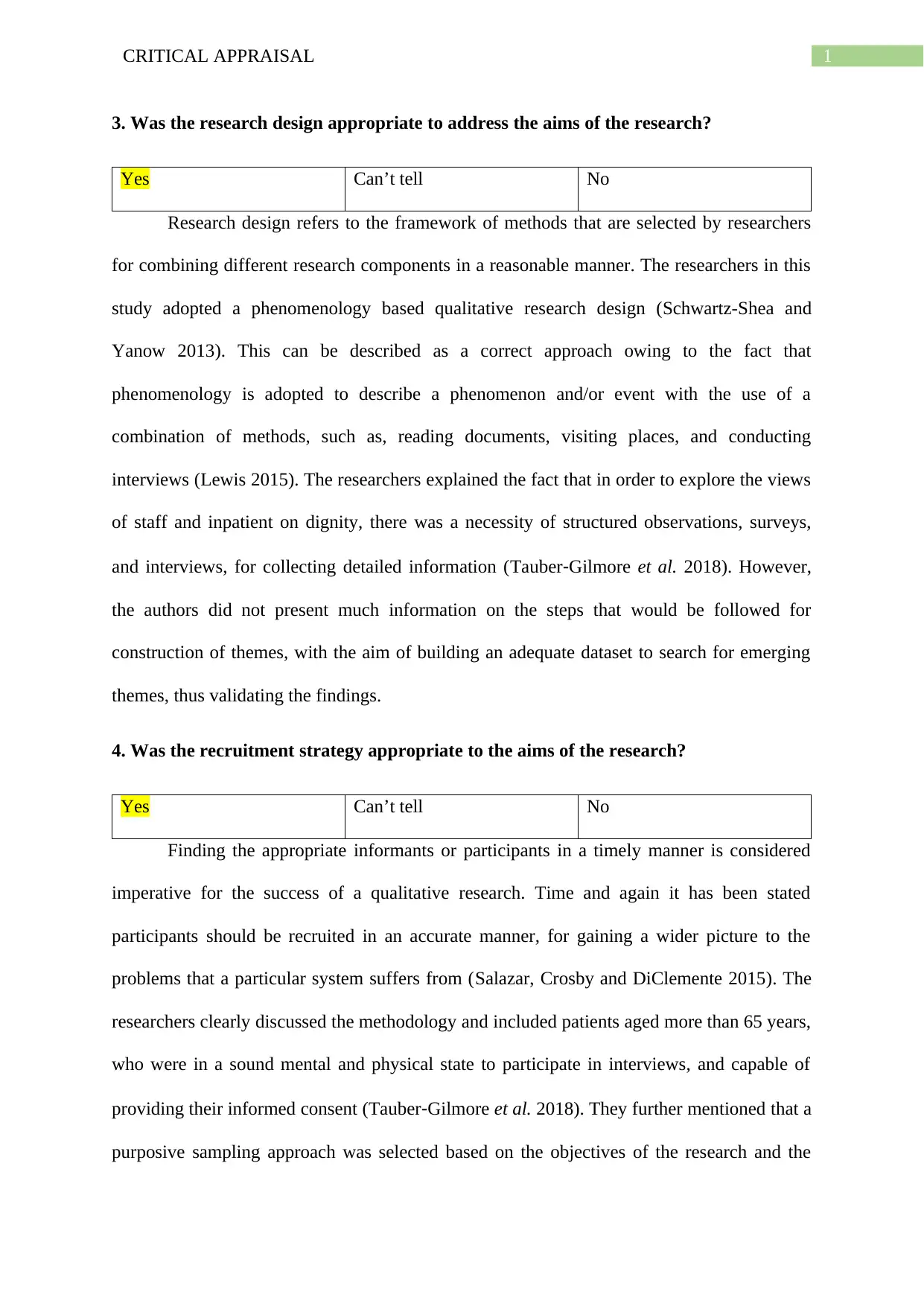
1CRITICAL APPRAISAL
3. Was the research design appropriate to address the aims of the research?
Yes Can’t tell No
Research design refers to the framework of methods that are selected by researchers
for combining different research components in a reasonable manner. The researchers in this
study adopted a phenomenology based qualitative research design (Schwartz-Shea and
Yanow 2013). This can be described as a correct approach owing to the fact that
phenomenology is adopted to describe a phenomenon and/or event with the use of a
combination of methods, such as, reading documents, visiting places, and conducting
interviews (Lewis 2015). The researchers explained the fact that in order to explore the views
of staff and inpatient on dignity, there was a necessity of structured observations, surveys,
and interviews, for collecting detailed information (Tauber‐Gilmore et al. 2018). However,
the authors did not present much information on the steps that would be followed for
construction of themes, with the aim of building an adequate dataset to search for emerging
themes, thus validating the findings.
4. Was the recruitment strategy appropriate to the aims of the research?
Yes Can’t tell No
Finding the appropriate informants or participants in a timely manner is considered
imperative for the success of a qualitative research. Time and again it has been stated
participants should be recruited in an accurate manner, for gaining a wider picture to the
problems that a particular system suffers from (Salazar, Crosby and DiClemente 2015). The
researchers clearly discussed the methodology and included patients aged more than 65 years,
who were in a sound mental and physical state to participate in interviews, and capable of
providing their informed consent (Tauber‐Gilmore et al. 2018). They further mentioned that a
purposive sampling approach was selected based on the objectives of the research and the
3. Was the research design appropriate to address the aims of the research?
Yes Can’t tell No
Research design refers to the framework of methods that are selected by researchers
for combining different research components in a reasonable manner. The researchers in this
study adopted a phenomenology based qualitative research design (Schwartz-Shea and
Yanow 2013). This can be described as a correct approach owing to the fact that
phenomenology is adopted to describe a phenomenon and/or event with the use of a
combination of methods, such as, reading documents, visiting places, and conducting
interviews (Lewis 2015). The researchers explained the fact that in order to explore the views
of staff and inpatient on dignity, there was a necessity of structured observations, surveys,
and interviews, for collecting detailed information (Tauber‐Gilmore et al. 2018). However,
the authors did not present much information on the steps that would be followed for
construction of themes, with the aim of building an adequate dataset to search for emerging
themes, thus validating the findings.
4. Was the recruitment strategy appropriate to the aims of the research?
Yes Can’t tell No
Finding the appropriate informants or participants in a timely manner is considered
imperative for the success of a qualitative research. Time and again it has been stated
participants should be recruited in an accurate manner, for gaining a wider picture to the
problems that a particular system suffers from (Salazar, Crosby and DiClemente 2015). The
researchers clearly discussed the methodology and included patients aged more than 65 years,
who were in a sound mental and physical state to participate in interviews, and capable of
providing their informed consent (Tauber‐Gilmore et al. 2018). They further mentioned that a
purposive sampling approach was selected based on the objectives of the research and the

2CRITICAL APPRAISAL
characteristics of the target population. The researchers also explained that dissemination of
posters in hospital communal areas helped in inviting staff from different disciplines and
nurses who worked on project wards. According to Palinkas et al. (2015) one major
advantage of this sampling procedure can be accredited to the fact that this technique
provided the researchers with adequate justification for making generalisations from the large
sample that is being investigated. In addition, the sampling technique adopted by the
researchers was also beneficial in providing a plethora of non-probability sampling methods
for the investigators to draw on. Furthermore, the authors also discussed about the use of
snowballing technique for recruiting staff interviewees. This allowed them to reach people
who were difficult to sample, with other techniques (Ritchie, Lewis and Elam 2013).
5. Was the data collected in a way that addressed the research issue?
Yes Can’t tell No
Research setting refers to the social, physical and cultural site where the researchers
conduct their study. Owing to the fact that qualitative research basically depends upon
meaning-making, the participants are typically studied in natural settings (Fernandez et al.
2013). The same was followed by the researchers, which can be attributed to the fact that
participant selection was done from 17 wards, located an acute healthcare organisation in
London, amid three different hospital sites (Tauber‐Gilmore et al. 2018). Owing to the fact
that the study aimed to conduct interview of the patients and staff for exploring their
experiences, this research setting was justified. The data collection process was quite clear.
Patients were subjected to interviews in their wards, while the staff were interviewed in the
hospital premises or their private offices. The researchers were clearly presented the fact that
similar queries were shaped for both the interview schedules, with the aim of ensuring similar
themes, for the two groups. They also provided an explicit information on the interview
schedule in a tabular format, by eliciting the questions that were asked. Conducting
characteristics of the target population. The researchers also explained that dissemination of
posters in hospital communal areas helped in inviting staff from different disciplines and
nurses who worked on project wards. According to Palinkas et al. (2015) one major
advantage of this sampling procedure can be accredited to the fact that this technique
provided the researchers with adequate justification for making generalisations from the large
sample that is being investigated. In addition, the sampling technique adopted by the
researchers was also beneficial in providing a plethora of non-probability sampling methods
for the investigators to draw on. Furthermore, the authors also discussed about the use of
snowballing technique for recruiting staff interviewees. This allowed them to reach people
who were difficult to sample, with other techniques (Ritchie, Lewis and Elam 2013).
5. Was the data collected in a way that addressed the research issue?
Yes Can’t tell No
Research setting refers to the social, physical and cultural site where the researchers
conduct their study. Owing to the fact that qualitative research basically depends upon
meaning-making, the participants are typically studied in natural settings (Fernandez et al.
2013). The same was followed by the researchers, which can be attributed to the fact that
participant selection was done from 17 wards, located an acute healthcare organisation in
London, amid three different hospital sites (Tauber‐Gilmore et al. 2018). Owing to the fact
that the study aimed to conduct interview of the patients and staff for exploring their
experiences, this research setting was justified. The data collection process was quite clear.
Patients were subjected to interviews in their wards, while the staff were interviewed in the
hospital premises or their private offices. The researchers were clearly presented the fact that
similar queries were shaped for both the interview schedules, with the aim of ensuring similar
themes, for the two groups. They also provided an explicit information on the interview
schedule in a tabular format, by eliciting the questions that were asked. Conducting
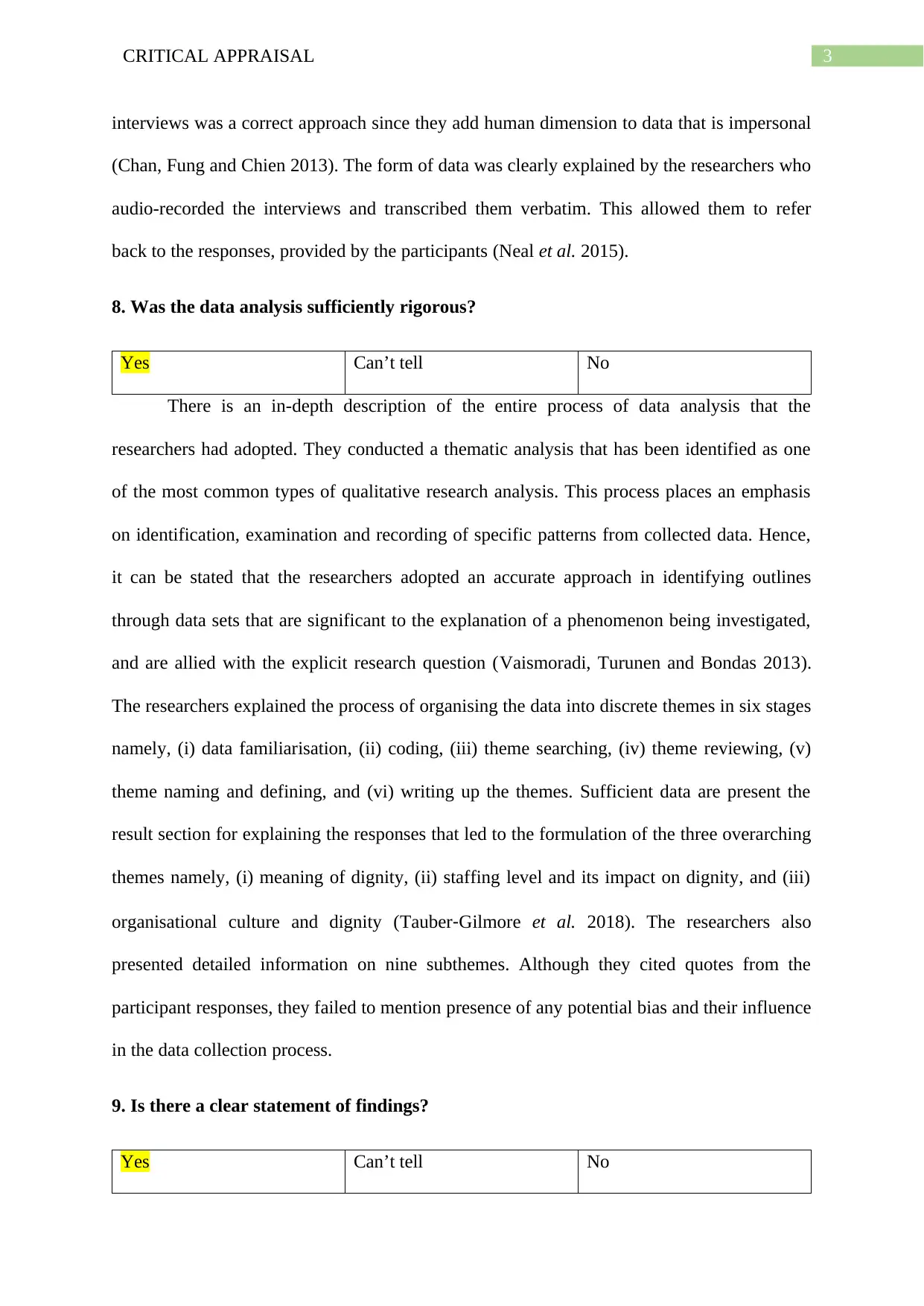
3CRITICAL APPRAISAL
interviews was a correct approach since they add human dimension to data that is impersonal
(Chan, Fung and Chien 2013). The form of data was clearly explained by the researchers who
audio-recorded the interviews and transcribed them verbatim. This allowed them to refer
back to the responses, provided by the participants (Neal et al. 2015).
8. Was the data analysis sufficiently rigorous?
Yes Can’t tell No
There is an in-depth description of the entire process of data analysis that the
researchers had adopted. They conducted a thematic analysis that has been identified as one
of the most common types of qualitative research analysis. This process places an emphasis
on identification, examination and recording of specific patterns from collected data. Hence,
it can be stated that the researchers adopted an accurate approach in identifying outlines
through data sets that are significant to the explanation of a phenomenon being investigated,
and are allied with the explicit research question (Vaismoradi, Turunen and Bondas 2013).
The researchers explained the process of organising the data into discrete themes in six stages
namely, (i) data familiarisation, (ii) coding, (iii) theme searching, (iv) theme reviewing, (v)
theme naming and defining, and (vi) writing up the themes. Sufficient data are present the
result section for explaining the responses that led to the formulation of the three overarching
themes namely, (i) meaning of dignity, (ii) staffing level and its impact on dignity, and (iii)
organisational culture and dignity (Tauber‐Gilmore et al. 2018). The researchers also
presented detailed information on nine subthemes. Although they cited quotes from the
participant responses, they failed to mention presence of any potential bias and their influence
in the data collection process.
9. Is there a clear statement of findings?
Yes Can’t tell No
interviews was a correct approach since they add human dimension to data that is impersonal
(Chan, Fung and Chien 2013). The form of data was clearly explained by the researchers who
audio-recorded the interviews and transcribed them verbatim. This allowed them to refer
back to the responses, provided by the participants (Neal et al. 2015).
8. Was the data analysis sufficiently rigorous?
Yes Can’t tell No
There is an in-depth description of the entire process of data analysis that the
researchers had adopted. They conducted a thematic analysis that has been identified as one
of the most common types of qualitative research analysis. This process places an emphasis
on identification, examination and recording of specific patterns from collected data. Hence,
it can be stated that the researchers adopted an accurate approach in identifying outlines
through data sets that are significant to the explanation of a phenomenon being investigated,
and are allied with the explicit research question (Vaismoradi, Turunen and Bondas 2013).
The researchers explained the process of organising the data into discrete themes in six stages
namely, (i) data familiarisation, (ii) coding, (iii) theme searching, (iv) theme reviewing, (v)
theme naming and defining, and (vi) writing up the themes. Sufficient data are present the
result section for explaining the responses that led to the formulation of the three overarching
themes namely, (i) meaning of dignity, (ii) staffing level and its impact on dignity, and (iii)
organisational culture and dignity (Tauber‐Gilmore et al. 2018). The researchers also
presented detailed information on nine subthemes. Although they cited quotes from the
participant responses, they failed to mention presence of any potential bias and their influence
in the data collection process.
9. Is there a clear statement of findings?
Yes Can’t tell No
Secure Best Marks with AI Grader
Need help grading? Try our AI Grader for instant feedback on your assignments.
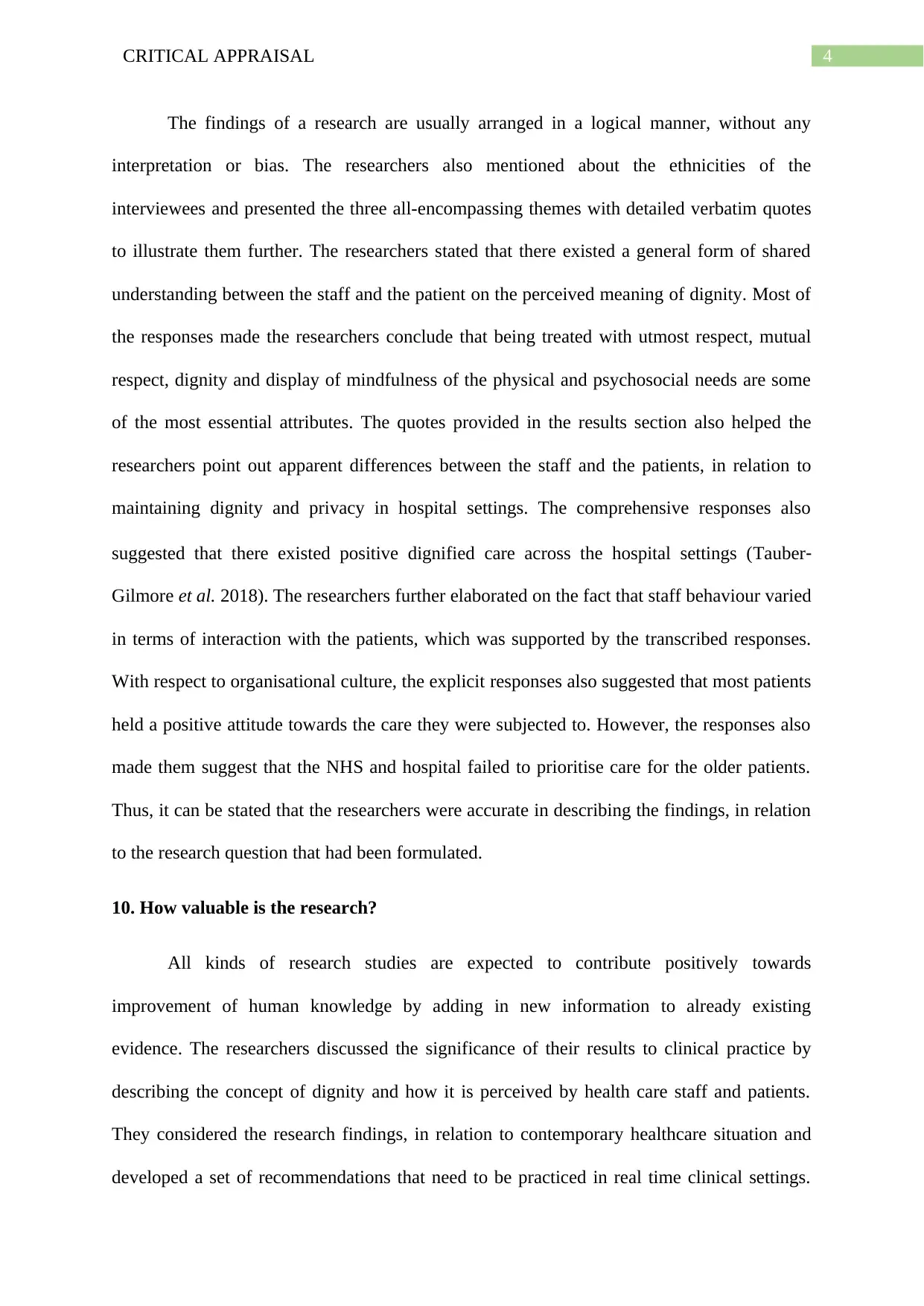
4CRITICAL APPRAISAL
The findings of a research are usually arranged in a logical manner, without any
interpretation or bias. The researchers also mentioned about the ethnicities of the
interviewees and presented the three all-encompassing themes with detailed verbatim quotes
to illustrate them further. The researchers stated that there existed a general form of shared
understanding between the staff and the patient on the perceived meaning of dignity. Most of
the responses made the researchers conclude that being treated with utmost respect, mutual
respect, dignity and display of mindfulness of the physical and psychosocial needs are some
of the most essential attributes. The quotes provided in the results section also helped the
researchers point out apparent differences between the staff and the patients, in relation to
maintaining dignity and privacy in hospital settings. The comprehensive responses also
suggested that there existed positive dignified care across the hospital settings (Tauber‐
Gilmore et al. 2018). The researchers further elaborated on the fact that staff behaviour varied
in terms of interaction with the patients, which was supported by the transcribed responses.
With respect to organisational culture, the explicit responses also suggested that most patients
held a positive attitude towards the care they were subjected to. However, the responses also
made them suggest that the NHS and hospital failed to prioritise care for the older patients.
Thus, it can be stated that the researchers were accurate in describing the findings, in relation
to the research question that had been formulated.
10. How valuable is the research?
All kinds of research studies are expected to contribute positively towards
improvement of human knowledge by adding in new information to already existing
evidence. The researchers discussed the significance of their results to clinical practice by
describing the concept of dignity and how it is perceived by health care staff and patients.
They considered the research findings, in relation to contemporary healthcare situation and
developed a set of recommendations that need to be practiced in real time clinical settings.
The findings of a research are usually arranged in a logical manner, without any
interpretation or bias. The researchers also mentioned about the ethnicities of the
interviewees and presented the three all-encompassing themes with detailed verbatim quotes
to illustrate them further. The researchers stated that there existed a general form of shared
understanding between the staff and the patient on the perceived meaning of dignity. Most of
the responses made the researchers conclude that being treated with utmost respect, mutual
respect, dignity and display of mindfulness of the physical and psychosocial needs are some
of the most essential attributes. The quotes provided in the results section also helped the
researchers point out apparent differences between the staff and the patients, in relation to
maintaining dignity and privacy in hospital settings. The comprehensive responses also
suggested that there existed positive dignified care across the hospital settings (Tauber‐
Gilmore et al. 2018). The researchers further elaborated on the fact that staff behaviour varied
in terms of interaction with the patients, which was supported by the transcribed responses.
With respect to organisational culture, the explicit responses also suggested that most patients
held a positive attitude towards the care they were subjected to. However, the responses also
made them suggest that the NHS and hospital failed to prioritise care for the older patients.
Thus, it can be stated that the researchers were accurate in describing the findings, in relation
to the research question that had been formulated.
10. How valuable is the research?
All kinds of research studies are expected to contribute positively towards
improvement of human knowledge by adding in new information to already existing
evidence. The researchers discussed the significance of their results to clinical practice by
describing the concept of dignity and how it is perceived by health care staff and patients.
They considered the research findings, in relation to contemporary healthcare situation and
developed a set of recommendations that need to be practiced in real time clinical settings.
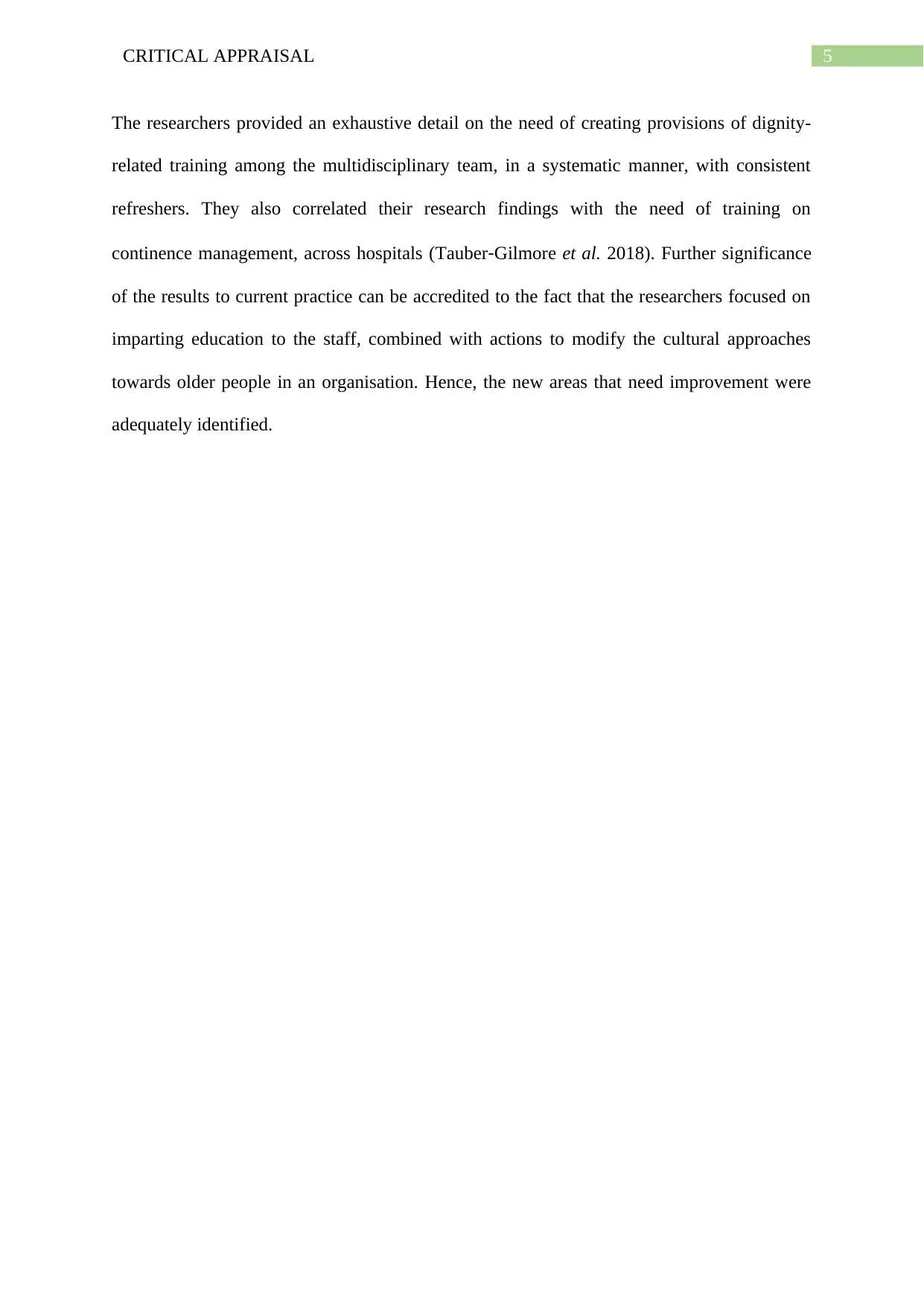
5CRITICAL APPRAISAL
The researchers provided an exhaustive detail on the need of creating provisions of dignity-
related training among the multidisciplinary team, in a systematic manner, with consistent
refreshers. They also correlated their research findings with the need of training on
continence management, across hospitals (Tauber‐Gilmore et al. 2018). Further significance
of the results to current practice can be accredited to the fact that the researchers focused on
imparting education to the staff, combined with actions to modify the cultural approaches
towards older people in an organisation. Hence, the new areas that need improvement were
adequately identified.
The researchers provided an exhaustive detail on the need of creating provisions of dignity-
related training among the multidisciplinary team, in a systematic manner, with consistent
refreshers. They also correlated their research findings with the need of training on
continence management, across hospitals (Tauber‐Gilmore et al. 2018). Further significance
of the results to current practice can be accredited to the fact that the researchers focused on
imparting education to the staff, combined with actions to modify the cultural approaches
towards older people in an organisation. Hence, the new areas that need improvement were
adequately identified.
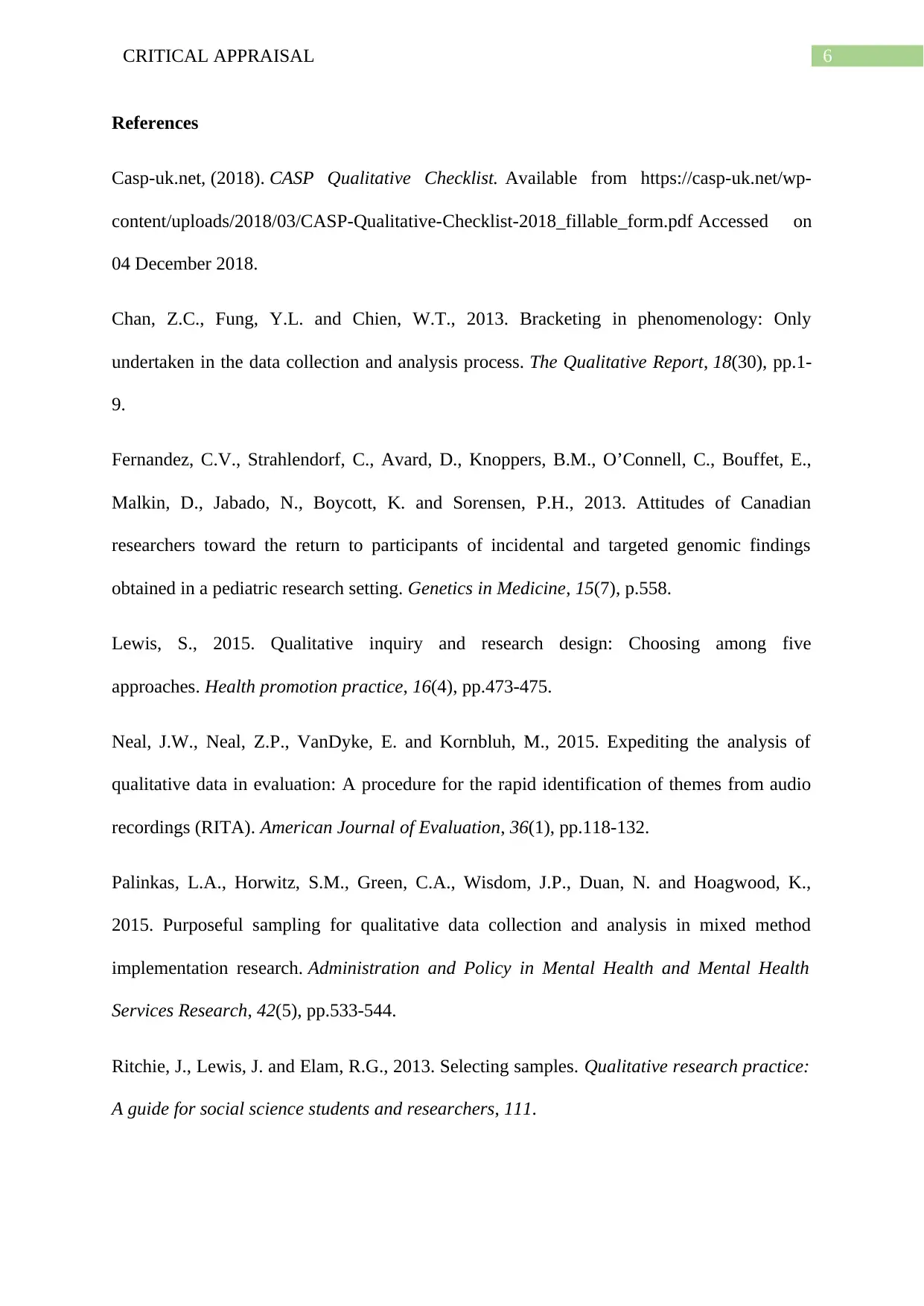
6CRITICAL APPRAISAL
References
Casp-uk.net, (2018). CASP Qualitative Checklist. Available from https://casp-uk.net/wp-
content/uploads/2018/03/CASP-Qualitative-Checklist-2018_fillable_form.pdf Accessed on
04 December 2018.
Chan, Z.C., Fung, Y.L. and Chien, W.T., 2013. Bracketing in phenomenology: Only
undertaken in the data collection and analysis process. The Qualitative Report, 18(30), pp.1-
9.
Fernandez, C.V., Strahlendorf, C., Avard, D., Knoppers, B.M., O’Connell, C., Bouffet, E.,
Malkin, D., Jabado, N., Boycott, K. and Sorensen, P.H., 2013. Attitudes of Canadian
researchers toward the return to participants of incidental and targeted genomic findings
obtained in a pediatric research setting. Genetics in Medicine, 15(7), p.558.
Lewis, S., 2015. Qualitative inquiry and research design: Choosing among five
approaches. Health promotion practice, 16(4), pp.473-475.
Neal, J.W., Neal, Z.P., VanDyke, E. and Kornbluh, M., 2015. Expediting the analysis of
qualitative data in evaluation: A procedure for the rapid identification of themes from audio
recordings (RITA). American Journal of Evaluation, 36(1), pp.118-132.
Palinkas, L.A., Horwitz, S.M., Green, C.A., Wisdom, J.P., Duan, N. and Hoagwood, K.,
2015. Purposeful sampling for qualitative data collection and analysis in mixed method
implementation research. Administration and Policy in Mental Health and Mental Health
Services Research, 42(5), pp.533-544.
Ritchie, J., Lewis, J. and Elam, R.G., 2013. Selecting samples. Qualitative research practice:
A guide for social science students and researchers, 111.
References
Casp-uk.net, (2018). CASP Qualitative Checklist. Available from https://casp-uk.net/wp-
content/uploads/2018/03/CASP-Qualitative-Checklist-2018_fillable_form.pdf Accessed on
04 December 2018.
Chan, Z.C., Fung, Y.L. and Chien, W.T., 2013. Bracketing in phenomenology: Only
undertaken in the data collection and analysis process. The Qualitative Report, 18(30), pp.1-
9.
Fernandez, C.V., Strahlendorf, C., Avard, D., Knoppers, B.M., O’Connell, C., Bouffet, E.,
Malkin, D., Jabado, N., Boycott, K. and Sorensen, P.H., 2013. Attitudes of Canadian
researchers toward the return to participants of incidental and targeted genomic findings
obtained in a pediatric research setting. Genetics in Medicine, 15(7), p.558.
Lewis, S., 2015. Qualitative inquiry and research design: Choosing among five
approaches. Health promotion practice, 16(4), pp.473-475.
Neal, J.W., Neal, Z.P., VanDyke, E. and Kornbluh, M., 2015. Expediting the analysis of
qualitative data in evaluation: A procedure for the rapid identification of themes from audio
recordings (RITA). American Journal of Evaluation, 36(1), pp.118-132.
Palinkas, L.A., Horwitz, S.M., Green, C.A., Wisdom, J.P., Duan, N. and Hoagwood, K.,
2015. Purposeful sampling for qualitative data collection and analysis in mixed method
implementation research. Administration and Policy in Mental Health and Mental Health
Services Research, 42(5), pp.533-544.
Ritchie, J., Lewis, J. and Elam, R.G., 2013. Selecting samples. Qualitative research practice:
A guide for social science students and researchers, 111.
Paraphrase This Document
Need a fresh take? Get an instant paraphrase of this document with our AI Paraphraser
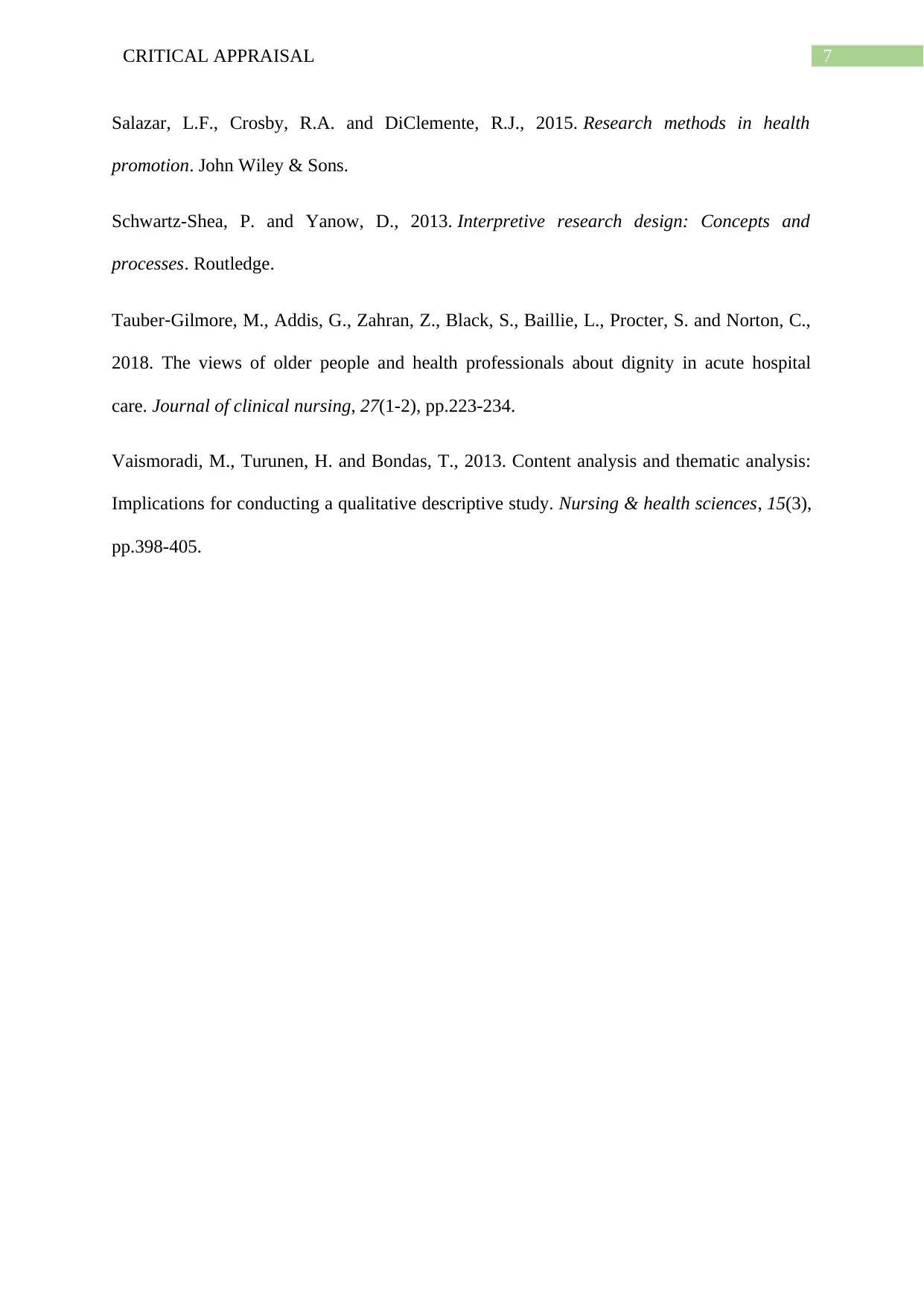
7CRITICAL APPRAISAL
Salazar, L.F., Crosby, R.A. and DiClemente, R.J., 2015. Research methods in health
promotion. John Wiley & Sons.
Schwartz-Shea, P. and Yanow, D., 2013. Interpretive research design: Concepts and
processes. Routledge.
Tauber‐Gilmore, M., Addis, G., Zahran, Z., Black, S., Baillie, L., Procter, S. and Norton, C.,
2018. The views of older people and health professionals about dignity in acute hospital
care. Journal of clinical nursing, 27(1-2), pp.223-234.
Vaismoradi, M., Turunen, H. and Bondas, T., 2013. Content analysis and thematic analysis:
Implications for conducting a qualitative descriptive study. Nursing & health sciences, 15(3),
pp.398-405.
Salazar, L.F., Crosby, R.A. and DiClemente, R.J., 2015. Research methods in health
promotion. John Wiley & Sons.
Schwartz-Shea, P. and Yanow, D., 2013. Interpretive research design: Concepts and
processes. Routledge.
Tauber‐Gilmore, M., Addis, G., Zahran, Z., Black, S., Baillie, L., Procter, S. and Norton, C.,
2018. The views of older people and health professionals about dignity in acute hospital
care. Journal of clinical nursing, 27(1-2), pp.223-234.
Vaismoradi, M., Turunen, H. and Bondas, T., 2013. Content analysis and thematic analysis:
Implications for conducting a qualitative descriptive study. Nursing & health sciences, 15(3),
pp.398-405.
1 out of 8
Related Documents
Your All-in-One AI-Powered Toolkit for Academic Success.
+13062052269
info@desklib.com
Available 24*7 on WhatsApp / Email
![[object Object]](/_next/static/media/star-bottom.7253800d.svg)
Unlock your academic potential
© 2024 | Zucol Services PVT LTD | All rights reserved.





